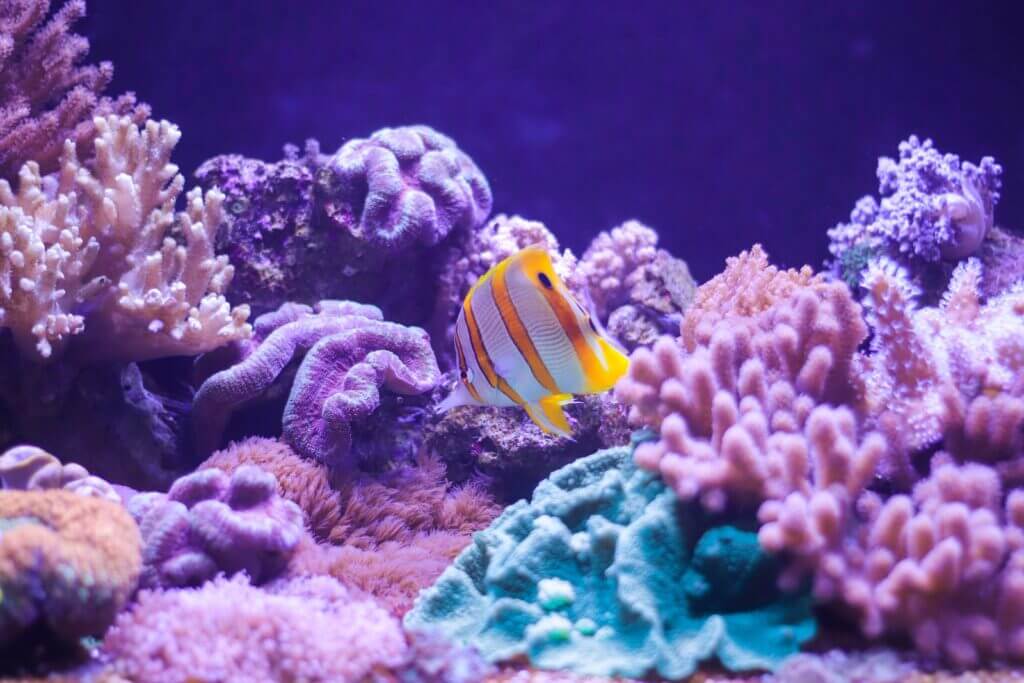Maintaining low phosphate levels is crucial for a healthy reef aquarium. But what’s the best way to reduce phosphates quickly and safely? In this guide, you’ll learn why phosphates cause problems and explore proven methods to optimize phosphate levels, including skimmers, refugiums, specialty media, water changes, and more. Follow these tips to clear up nuisance algae, improve coral growth, and create pristine reef conditions.
What Are Phosphates and Why Are They Harmful in Reef Tanks?
Phosphates are naturally occurring organic chemical compounds containing the mineral phosphorus. They enter the reef tank through fish food, coral waste, and top off water, then fuel nuisance algae growth if allowed to accumulate.
The primary source is orthophosphate, the form of soluble reactive phosphate directly usable by algae and cyanobacteria. Even very low levels, 0.03 – 0.05 ppm, can trigger blooms.
Elevated phosphates negatively impact reef tanks and corals through:
- Promoting growth of undesirable algae and cyano bacteria that smother corals
- Increasing biofouling of sand, live rock, and tank surfaces
- Causing stunting, discoloration, and bleaching of SPS and other corals
- Creating competition between algae and corals for nutrients like carbon, nitrogen, and iron
That’s why aquarists must maintain undetectable phosphate readings through export, chemical media, and dilution to protect coral health and prevent algae takeovers.
How to Test for Phosphates
The key is knowing your reef tank’s current phosphate levels through water tests. Hobby grade phosphate test kits use liquid reagents that react with orthophosphates and change color based on concentration.
Color charts convert the observed color into a phosphate measurement in parts per million (ppm). Accurate results require careful observation and comparison. More advanced electronic photometers can test phosphates automatically.
Ideally, target 0 ppm by the test kit’s lowest sensitivity – usually around 0.02 to 0.05 ppm. Even these trace levels can sustain nuisance algae. Test weekly to monitor conditions. If phosphates creep up, take immediate action using the methods below.
Different Ways to Lower Phosphates in Reef Tanks
There are several effective techniques and equipment to reduce elevated phosphate levels in reef systems:
Protein Skimmers
Protein skimmers are a must-have on most reef tanks. They actively strip phosphates and other organic waste from the water before they decompose and cause algae growth.
Target 10-20x tank volume turnover per hour for enough skimming capacity. Clean the collection cup frequently to remove accumulated phosphates.
Refugiums
Refugiums are secondary filtration chambers attached to the main tank. They cultivate beneficial macroalgae that uptake phosphates for growth. Chaetomorpha is commonly used.
Remove excess algae frequently to export phosphates. Dense refugium growth also outcompetes algae in the display.
Granular Ferric Oxide (GFO)
GFO is an iron-oxide coated filtering media that adsorbs phosphates from the water. Flow-through reactor setups maximize contact. Use 100mL of GFO per 50 gallons.
Phosphates cling to the GFO, eventually requiring replacement when exhausted. Change out GFO when phosphate levels start to climb.
Lanthanum Chloride
Lanthanum chloride binds tightly with phosphates to form an insoluble precipitate that gets trapped in the filter. It can eliminate even stubborn cyano algae issues.
Use with caution, as lanthanum accumulates over time. Make small initial doses of 0.1mg/L and increase gradually if needed.
Water Changes
Frequent partial water changes are key to diluting phosphates. Aim for 10-20% weekly or biweekly depending on stocking levels. Use phosphate-free RO/DI water for changes.
Larger volume changes of 30-40% may be needed to reset high phosphate tanks. Siphon all debris from rock and sand at each change.
Macroalgae
Live macroalgae assimilates phosphates for growth. Include fast growing types like chaetomorpha, caulerpa, and ulva to soak up excess phosphates and outcompete nuisance algae.
Remove mature algae frequently to physically export phosphates. Target at least 2-4 oz. of macroalgae per gallon of tank volume.
Combining several methods creates a comprehensive approach to phosphate control. For example, water changes and GFO tackle phosphates in the water column while macroalgae absorbs and exports waste.
Tips for Lowering Phosphates Quickly and Safely
Here are some key tips for reducing phosphates efficiently while avoiding potential downsides of some methods:
- Gradually increase removers like GFO and lanthanum chloride to avoid crashing your cycle. Start with 50% of recommended dose.
- When using phosphate removers, maintain nitrates and calcium levels since they may decline too. Supplement if needed.
- Test phosphate at least weekly to gauge methods’ effectiveness and make adjustments. Shoot for 0 ppm.
- Increase water change frequency and volume if phosphates remain elevated. Clean filters, skimmers and pumps thoroughly during changes.
- Remove mature macroalgae frequently, before dying off and decomposing in the tank, which releases phosphates.
- Use RO/DI water for make up and changes to avoid reintroducing phosphates. Keep RO/DI system filters fresh.
- Reduce feeding to avoid excess nutrient input. Soak foods in RO/DI water to leach out phosphates before feeding.
- Manually remove nuisance algae frequently by siphoning and scrubbing rocks and sand beds. Algae stores phosphates.
With routine testing and a proactive approach, your phosphates will remain undetectable, algae will be controlled, and corals will thrive with excellent growth and coloration.
Conclusion
Uncontrolled phosphates wreak havoc on reef tanks by promoting algae overgrowth that smothers coral. Luckily several effective options exist to reduce phosphates for a pristine system, including protein skimming, refugiums, specialty media like GFO, lanthanum dosing, large water changes, and macroalgae growth.
Test phosphate levels regularly to detect problems early. Then use a combination of methods, like water changes plus GFO or algae plus a skimmer, to bring phosphates down to undetectable levels quickly and safely. With a rigorous routine focused on export and removal, your tank will maintain a healthy balance for your prized corals.






